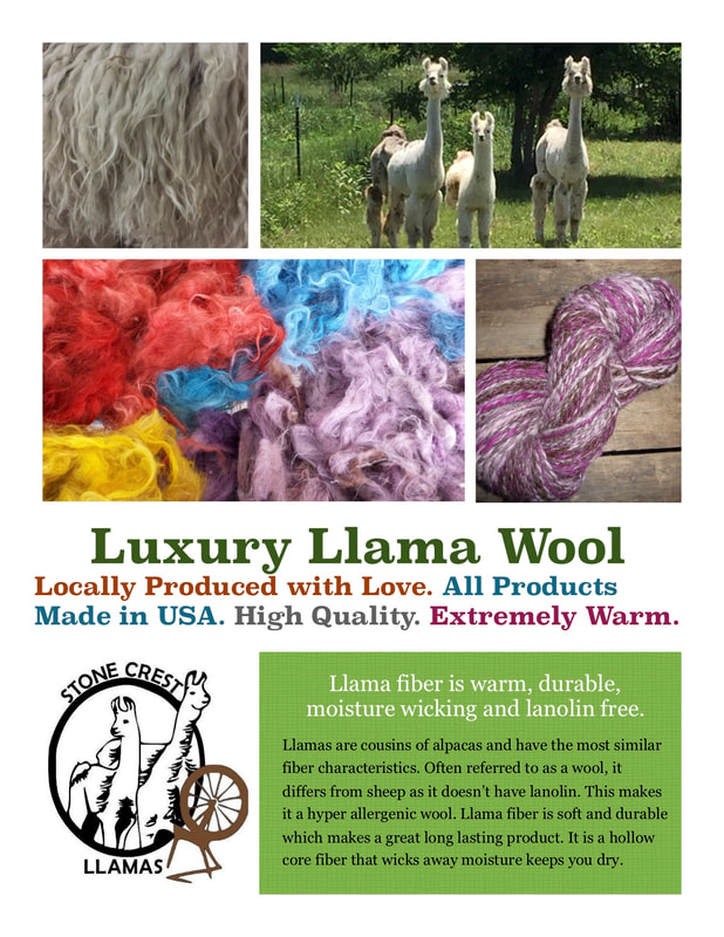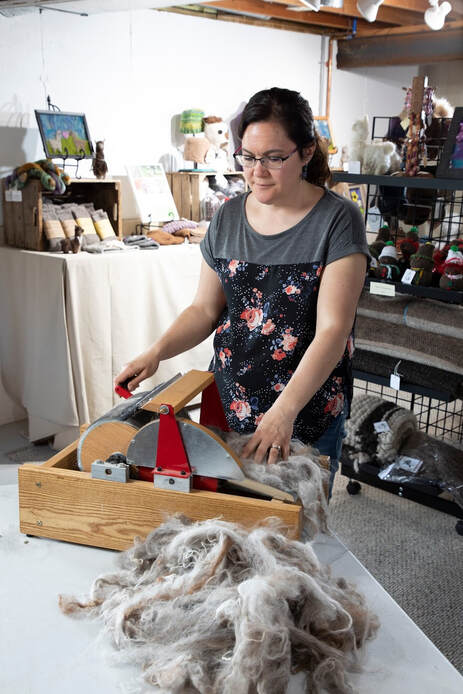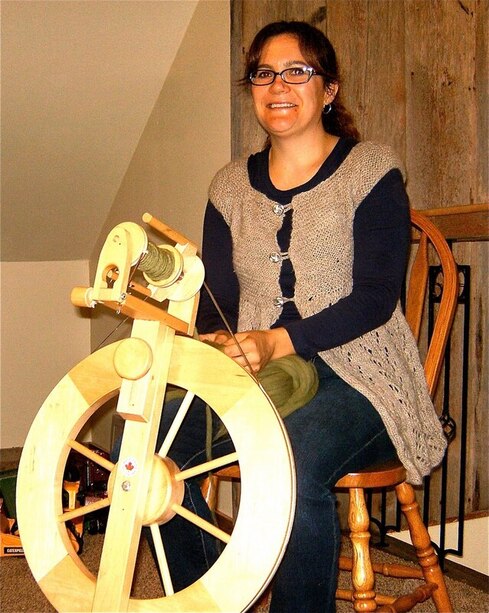Why Your next Purchase Should be a Llama Wool Product
- Warm- one of the warmest natural fibers on earth.
- Moisture Wicking- It's hollow core will pull away moisture.
- Hypo-Allergenic- Most of you who can't wear wool will find llama to be comfortable as it doesn't have lanolin.
- Flame Resistant- perfect for a rug in front of the fire, llama wool will not support a flame or melt.
- Anti-microbial- naturally llama wool not harbor bacteria to grow.
- Soft- llama wool has a low micron count and is soft to the touch, unlike some sheep wools.
- Quiet- this may sound odd, but you can wear something made from llama wool, and there is no noise of a crunching rustling sound. Perfect for hunting and bird watching.

Facts About Llama Fiber
Camelid (Llamas and Alpacas) yarn is very popular for knitting and crocheting. This is due to llama fiber's strength and softness with added warmth. Llama fiber is typically softer than sheep wool. It has a hollow core center that wicks away moisture. It is also water and fire resistant.
Llama wool does not contain lanolin, an oil that sheep produce which make it often a go to for people with wool allergies. Llama yarn is often used for next to the skin projects.
There are many types of llama fleeces. Classic, Heavy/Medium Wool, suri and silky.
The picture shows them all taken from Hidden Oaks Llama Ranch. From Left to Right.
HOLR Twenty One Guns (Classic)
HOLR Aristo (Heavy Wool)
GNLC Independence (Suri)
LUA The Showman
(Silky)
One of the benefits of 100% llama is its beautiful drape, so use 100% llama for shawl, scarves and accessories. Many like llama lace weight yarns when knitting or crocheting lace as the stitches will readily open up and show the pattern. 100% Llama yarns can be stretchy, so if you are looking to make a sweater or hat then we recommend adding a yarn that has 20% wool.
There is not a single perfect fiber, one way or another there is something lacking. They all have some good, fair and poor characteristics. In an effort to produce perfect yarns the production of blended fibers has come about. Blended yarns contain two or more different fibers resulting in a yarn with improved overall characteristics. If blending is done carefully the good qualities of the fibers are emphasized and the poorer qualities are minimized. This practice is generally accepted within the fiber world.
The important reason for blending fibers is to produce better performance. Blending can improve the characteristics that are poor in one fiber by blending it with another type of fiber that excel in those characteristics. I like 3 kinds of blends.
1. Addition of 20% fine sheep wool to llama gives the yarn more elasticity, this is great for sweaters.
2. Addition of 10% Angora rabbit will result in a yarn with a halo.
3. Addition 10 to 30% mohair will make a loftier yarn and give it a fuzzy look.
Camelid (Llamas and Alpacas) yarn is very popular for knitting and crocheting. This is due to llama fiber's strength and softness with added warmth. Llama fiber is typically softer than sheep wool. It has a hollow core center that wicks away moisture. It is also water and fire resistant.
Llama wool does not contain lanolin, an oil that sheep produce which make it often a go to for people with wool allergies. Llama yarn is often used for next to the skin projects.
There are many types of llama fleeces. Classic, Heavy/Medium Wool, suri and silky.
The picture shows them all taken from Hidden Oaks Llama Ranch. From Left to Right.
HOLR Twenty One Guns (Classic)
HOLR Aristo (Heavy Wool)
GNLC Independence (Suri)
LUA The Showman
(Silky)
One of the benefits of 100% llama is its beautiful drape, so use 100% llama for shawl, scarves and accessories. Many like llama lace weight yarns when knitting or crocheting lace as the stitches will readily open up and show the pattern. 100% Llama yarns can be stretchy, so if you are looking to make a sweater or hat then we recommend adding a yarn that has 20% wool.
There is not a single perfect fiber, one way or another there is something lacking. They all have some good, fair and poor characteristics. In an effort to produce perfect yarns the production of blended fibers has come about. Blended yarns contain two or more different fibers resulting in a yarn with improved overall characteristics. If blending is done carefully the good qualities of the fibers are emphasized and the poorer qualities are minimized. This practice is generally accepted within the fiber world.
The important reason for blending fibers is to produce better performance. Blending can improve the characteristics that are poor in one fiber by blending it with another type of fiber that excel in those characteristics. I like 3 kinds of blends.
1. Addition of 20% fine sheep wool to llama gives the yarn more elasticity, this is great for sweaters.
2. Addition of 10% Angora rabbit will result in a yarn with a halo.
3. Addition 10 to 30% mohair will make a loftier yarn and give it a fuzzy look.
How We Process Our Fiber Here at Stone Crest Llamas
We now have 3 generations of fiber artist as Joyce, Jody and Jody's daughter spin, felt and weave. We are blessed that my sister in law also caught the fiber bug and helps out too. We all seem to share the love for making something beautiful out of the fleece that we shear each year. It is a very relaxing and rewarding process with unlimited ideas of what you can make.
Our llamas graze naturally in pastures with no pesticides or herbicides. They are happy and healthy animals and seem to enjoy being sheared as they know they will be cooler. Every spring as the weather warms in Wisconsin, usually towards the end of April our llamas are sheared. I, (Jody) do all of the shearing and the rest of the family help with catching, and sorting fleeces. It's a family event! Each fleece on our farm is individually skirted and then graded based on color and softness. There are around 25 natural shades of colors in browns, grays, white, cream and black. We than wash our fleeces in dawn dish soap and lay them out to dry. We select the fibers and color which are best for the end products we want to have made. Once it is dry it can be carded and spun. We also work with local mills to have finished items made.
Our llamas graze naturally in pastures with no pesticides or herbicides. They are happy and healthy animals and seem to enjoy being sheared as they know they will be cooler. Every spring as the weather warms in Wisconsin, usually towards the end of April our llamas are sheared. I, (Jody) do all of the shearing and the rest of the family help with catching, and sorting fleeces. It's a family event! Each fleece on our farm is individually skirted and then graded based on color and softness. There are around 25 natural shades of colors in browns, grays, white, cream and black. We than wash our fleeces in dawn dish soap and lay them out to dry. We select the fibers and color which are best for the end products we want to have made. Once it is dry it can be carded and spun. We also work with local mills to have finished items made.
Proudly powered by Weebly




